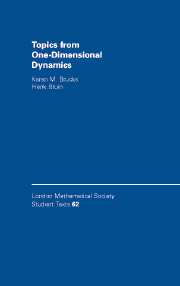Book contents
- Frontmatter
- Contents
- List of Figures
- Preface
- 1 Topological Roots
- 2 Measure Theoretic Roots
- 3 Beginning Symbolic and Topological Dynamics
- 4 Beginning Measurable Dynamics
- 5 A First Example: The 2∞ Map
- 6 Kneading Maps
- 7 Some Number Theory
- 8 Circle Maps
- 9 Topological Entropy
- 10 Symmetric Tent Maps
- 11 Unimodal Maps and Rigid Rotations
- 12 β-Transformations, Unimodal Maps, and Circle Maps
- 13 Homeomorphic Restrictions in the Unimodal Setting
- 14 Complex Quadratic Dynamics
- Bibliography
- Index
14 - Complex Quadratic Dynamics
Published online by Cambridge University Press: 05 August 2012
- Frontmatter
- Contents
- List of Figures
- Preface
- 1 Topological Roots
- 2 Measure Theoretic Roots
- 3 Beginning Symbolic and Topological Dynamics
- 4 Beginning Measurable Dynamics
- 5 A First Example: The 2∞ Map
- 6 Kneading Maps
- 7 Some Number Theory
- 8 Circle Maps
- 9 Topological Entropy
- 10 Symmetric Tent Maps
- 11 Unimodal Maps and Rigid Rotations
- 12 β-Transformations, Unimodal Maps, and Circle Maps
- 13 Homeomorphic Restrictions in the Unimodal Setting
- 14 Complex Quadratic Dynamics
- Bibliography
- Index
Summary
Complex dynamics (i.e., the theory of dynamical systems on the complex plane) is a rich area in which powerful techniques from complex analysis are available. In our presentation, we try to avoid the more involved techniques as much as possible. Therefore, we work in settings that allow simplified definitions and theorems yet still allow for challenging results. For example, our definition of Julia sets (Section 14.1) is only valid for polynomials, not for arbitrary analytic functions on ℂ. Comprehensive introductions can be found in [9, 50, 53, 64, 118, 121].
We only discuss quadratic polynomials on ℂ because they are the straightforward, and the most frequently studied, complexifications of unimodal maps. Our goal is to introduce and study symbolic dynamics of them. Just as in the real case, symbolic approaches give a lot of information on the various dynamical behaviors that the system can exhibit. In principle, itineraries can be defined for complex quadratic maps just the same as for real unimodal maps. The difficulty is that the Julia set, the set on which interesting dynamics take place, is much more complicated than the interval. Instead of just “left of the critical point” and “right of critical point,” we need to be much more inventive to decide on which side of the critical point points lie. To make this decision, we will introduce the notion of external rays and external angles. At that point, we will want to determine the external angle of a given point in the Julia set. This is the contents of Section 14.1.
- Type
- Chapter
- Information
- Topics from One-Dimensional Dynamics , pp. 250 - 278Publisher: Cambridge University PressPrint publication year: 2004



